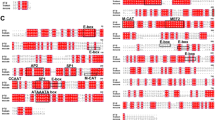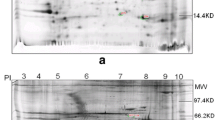Abstract
SRPK3 is a protein kinase belonging to serine/arginine protein kinases (SRPK) family, which phosphorylates serine/arginine repeat-containing proteins, and is controlled by a muscle-specific enhancer directly regulated by MEF2. In this study, a full-length cDNA of the porcine SRPK3 gene encoding a 566 amino acid protein was isolated. It contains 14 exons over approximately 4.3 kb. The deduced amino acid sequence of porcine SRPK3 contains a bipartite kinase domain, and shows high similarities to their corresponding human and cattle homologues. Tissue distribution analysis indicated that porcine SRPK3 mRNAs are highly expressed in heart and skeletal muscle especially in uterus and parorchis, but at low level in brain, stomach, small intestine, and ovary. Expression pattern of SRPK3 was similar in Large White and Chinese Meishan breeds. Both the two breeds had the highest expression levels at fetal 65 days (P < 0.01), and decreased while the age increased until 60 days old, then increased at 120 days (P < 0.01) and decreased at 180 days (P < 0.05). However, at fetal 65 days, the mRNA abundance of SRPK3 in Large White was 12.5-fold higher than in Meishan pigs (P < 0.01), whereas at 180 days, the abundance in Meishan was 3.4-fold higher than in Large White pigs (P < 0.01). These results suggest that the SRPK3 gene might be an important gene of skeletal muscle development and also provides basic molecular information useful for further studies on its roles in porcine skeletal muscle.



Similar content being viewed by others
References
Barnard DC, Patton JG (2000) Identification and characterization of a novel serine-arginine-rich splicing regulatory protein. Mol Cell Biol 20:3049–3057
Jang SW, Yang SJ, Ehlen A, Dong S et al (2008) Serine/arginine protein-specific kinase 2 promotes leukemia cell proliferation by phosphorylating acinus and regulating cyclin A1. Cancer Res 68:4559–4570
Tang Z, Kuo T, Shen J, Lin R-J (2000) Biochemical and genetic conservation of fission yeast Dsk1 and human SR protein-specific kinase 1. Mol Cell Biol 20:816–824
Kuroyanagi N, Onogi H, Wakabayashi T, Hagiwara M (1998) Novel SR-protein-specific kinase, SRPK2, disassembles nuclear speckles. Biochem Biophys Res Commun 242:357–364
Grosso AR, Gomes AQ, Barbosa-Morais NL, Caldeira S et al (2008) Tissue-specific splicing factor gene expression signatures. Nucleic Acids Res 36:4823–4832
Nikolakaki E, Kohen R, Hartmann AM, Stamm S et al (2001) Cloning and characterization of an alternatively spliced form of SR protein kinase 1 that interacts specifically with scaffold attachment factor-B. J Biol Chem 276:40175–40182
Colwill K, Pawson T, Andrews B, Prasad J et al (1996) The Clk/Sty protein kinase phosphorylates SR splicing factors and regulates their intranuclear distribution. EMBO J 15:265–275
Gui JF, Lane WS, Fu XD (1994) A serine kinase regulates intracellular localization of splicing factors in the cell cycle. Nature 369:678–682
Wang HY, Lin W, Dyck JA, Yeakley JM et al (1998) SRPK2: a differentially expressed SR protein-specific kinase involved in mediating the interaction and localization of pre-mRNA splicing factors in mammalian cells. J Cell Biol 140:737–750
Nakagawa O, Arnold M, Nakagawa M, Hamada H et al (2005) Centronuclear myopathy in mice lacking a novel muscle-specific protein kinase transcriptionally regulated by MEF2. Genes Dev 19:2066–2077
Mylonis I, Giannakouros T (2003) Protein kinase CK2 phosphorylates and activates the SR protein-specific kinase 1. Biochem Biophys Res Commun 301:650–656
Bassel-Duby R, Olson EN (2006) Signaling pathways in skeletal muscle remodeling. Annu Rev Biochem 75:19–37
Grunau C, Hindermann W, Rosenthal A (2000) Large-scale methylation analysis of human genomic DNA reveals tissue-specific differences between the methylation profiles of genes and pseudogenes. Hum Mol Genet 9:2651–2663
Ross MT, Grafham DV, Coffey AJ, Scherer S et al (2005) The DNA sequence of the human X chromosome. Nature 434:325–337
Waterston RH, Lindblad-Toh K, Birney E, Rogers J et al (2002) Initial sequencing and comparative analysis of the mouse genome. Nature 420:520–562
Yun CY, Fu XD (2000) Conserved SR protein kinase functions in nuclear import and its action is counteracted by arginine methylation in Saccharomyces cerevisiae. J Cell Biol 150:707–718
Li J, Hawkins IC, Harvey CD, Jennings JL et al (2003) Regulation of alternative splicing by SRrp86 and its interacting proteins. Mol Cell Biol 23:7437–7447
Haberland M, Arnold MA, McAnally J, Phan D et al (2007) Regulation of HDAC9 gene expression by MEF2 establishes a negative-feedback loop in the transcriptional circuitry of muscle differentiation. Mol Cell Biol 27:518–525
Wu H, Naya FJ, McKinsey TA, Mercer B et al (2000) MEF2 responds to multiple calcium-regulated signals in the control of skeletal muscle fiber type. EMBO J 19:1963–1973
Parker MH, Seale P, Rudnicki MA (2003) Looking back to the embryo: defining transcriptional networks in adult myogenesis. Nat Rev Genet 4:497–507
Picard B, Lefaucheur L, Berri C, Duclos MJ (2002) Muscle fibre ontogenesis in farm animal species. Reprod Nutr Dev 42:415–431
Lefaucheur L, Edom F, Ecolan P, Butler-Browne GS (1995) Pattern of muscle fiber type formation in the pig. Dev Dyn 203:27–41
Ford SP, Youngs CR (1993) Early embryonic development in prolific Meishan pigs. J Reprod Fertil Suppl 48:271–278
White BR, Lan YH, McKeith FK, Novakofski J et al (1995) Growth and body composition of Meishan and Yorkshire barrows and gilts. J Anim Sci 73:738–749
Rivera RM, Youngs CR, Ford SP (1996) A comparison of the number of inner cell mass and trophectoderm cells of preimplantation Meishan and Yorkshire pig embryos at similar developmental stages. J Reprod Fertil 106:111–116
Lefaucheur L, Milan D, Ecolan P, Le Callennec C (2004) Myosin heavy chain composition of different skeletal muscles in Large White and Meishan pigs. J Anim Sci 82:1931–1941
Wimmers K, Ngu NT, Jennen DGJ, Tesfaye D, Murani E, Schellander K, Ponsuksili S (2008) Relationship between myosin heavy chain isoform expression and muscling in several diverse pig breeds. J Anim Sci 86:795–803
Xu YJ, Jin ML, Wang LJ, Zhang AD et al (2009) Differential proteome analysis of porcine skeletal muscles between Meishan and Large White. J Anim Sci 87:2519–2527
Acknowledgements
This work was financially supported by the National Key Foundation Research and Development Program of China (2006CB102102) and Key and Specific National Project for Creating New Biological Species Transgenically (2008ZX08006-002).
Author information
Authors and Affiliations
Corresponding author
Additional information
Yongjie Xu and Wenmin Yu contributed equally to this work.
Electronic supplementary material
Below is the link to the electronic supplementary material.
Rights and permissions
About this article
Cite this article
Xu, Y., Yu, W., Xiong, Y. et al. Molecular characterization and expression patterns of serine/arginine-rich specific kinase 3 (SPRK3) in porcine skeletal muscle. Mol Biol Rep 38, 2903–2909 (2011). https://doi.org/10.1007/s11033-010-9952-1
Received:
Accepted:
Published:
Issue Date:
DOI: https://doi.org/10.1007/s11033-010-9952-1




